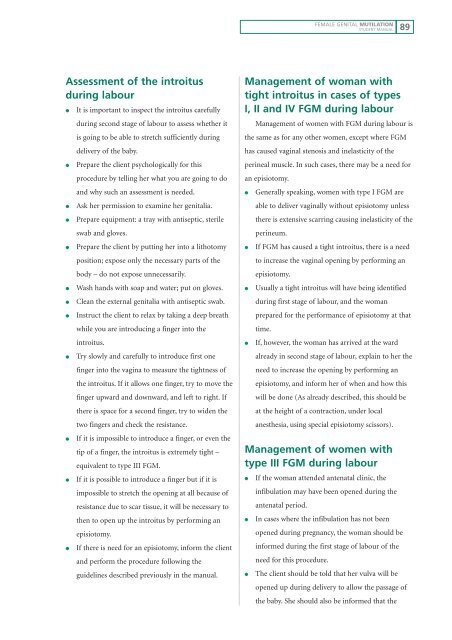Female Genital Mutilation - World Health Organization
Female Genital Mutilation - World Health Organization
Female Genital Mutilation - World Health Organization
Create successful ePaper yourself
Turn your PDF publications into a flip-book with our unique Google optimized e-Paper software.
Assessment of the introitus<br />
during labour<br />
● It is important to inspect the introitus carefully<br />
during second stage of labour to assess whether it<br />
is going to be able to stretch sufficiently during<br />
delivery of the baby.<br />
● Prepare the client psychologically for this<br />
procedure by telling her what you are going to do<br />
and why such an assessment is needed.<br />
● Ask her permission to examine her genitalia.<br />
● Prepare equipment: a tray with antiseptic, sterile<br />
swab and gloves.<br />
● Prepare the client by putting her into a lithotomy<br />
position; expose only the necessary parts of the<br />
body – do not expose unnecessarily.<br />
● Wash hands with soap and water; put on gloves.<br />
● Clean the external genitalia with antiseptic swab.<br />
● Instruct the client to relax by taking a deep breath<br />
while you are introducing a finger into the<br />
introitus.<br />
● Try slowly and carefully to introduce first one<br />
finger into the vagina to measure the tightness of<br />
the introitus. If it allows one finger, try to move the<br />
finger upward and downward, and left to right. If<br />
there is space for a second finger, try to widen the<br />
two fingers and check the resistance.<br />
● If it is impossible to introduce a finger, or even the<br />
tip of a finger, the introitus is extremely tight –<br />
equivalent to type III FGM.<br />
● If it is possible to introduce a finger but if it is<br />
impossible to stretch the opening at all because of<br />
resistance due to scar tissue, it will be necessary to<br />
then to open up the introitus by performing an<br />
episiotomy.<br />
● If there is need for an episiotomy, inform the client<br />
and perform the procedure following the<br />
guidelines described previously in the manual.<br />
FEMALE GENITAL MUTILATION<br />
STUDENT MANUAL<br />
Management of woman with<br />
tight introitus in cases of types<br />
I, II and IV FGM during labour<br />
Management of women with FGM during labour is<br />
the same as for any other women, except where FGM<br />
has caused vaginal stenosis and inelasticity of the<br />
perineal muscle. In such cases, there may be a need for<br />
an episiotomy.<br />
● Generally speaking, women with type I FGM are<br />
able to deliver vaginally without episiotomy unless<br />
there is extensive scarring causing inelasticity of the<br />
perineum.<br />
● If FGM has caused a tight introitus, there is a need<br />
to increase the vaginal opening by performing an<br />
episiotomy.<br />
● Usually a tight introitus will have being identified<br />
during first stage of labour, and the woman<br />
prepared for the performance of episiotomy at that<br />
time.<br />
● If, however, the woman has arrived at the ward<br />
already in second stage of labour, explain to her the<br />
need to increase the opening by performing an<br />
episiotomy, and inform her of when and how this<br />
will be done (As already described, this should be<br />
at the height of a contraction, under local<br />
anesthesia, using special episiotomy scissors).<br />
Management of women with<br />
type III FGM during labour<br />
89<br />
● If the woman attended antenatal clinic, the<br />
infibulation may have been opened during the<br />
antenatal period.<br />
● In cases where the infibulation has not been<br />
opened during pregnancy, the woman should be<br />
informed during the first stage of labour of the<br />
need for this procedure.<br />
● The client should be told that her vulva will be<br />
opened up during delivery to allow the passage of<br />
the baby. She should also be informed that the

















